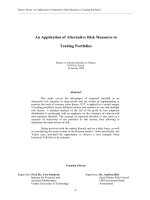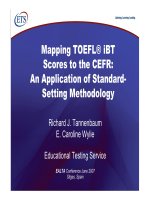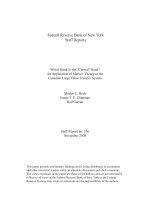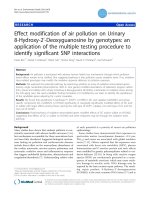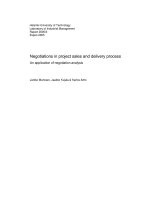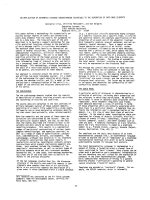An application of the multiple intelligences theory in projest based teaching the case of pilot textbook tieng anh 11 masters thesis in education theory and methods of teaching english 60 14 01 11
Bạn đang xem bản rút gọn của tài liệu. Xem và tải ngay bản đầy đủ của tài liệu tại đây (4.01 MB, 126 trang )
MINISTRY OF EDUCATION AND TRAINING
VINH UNIVERSITY
LE THI KIEU OANH
AN APPLICATION OF THE MULTIPLE INTELLIGENCES
THEORY IN PROJECT- BASED TEACHING:
THE CASE OF PILOT TEXTBOOK TIENG ANH 11
MASTER’S THESIS IN EDUCATION
NGHE AN, 2016
MINISTRY OF EDUCATION AND TRAINING
VINH UNIVERSITY
LE THI KIEU OANH
AN APPLICATION OF THE MULTIPLE INTELLIGENCES
THEORY IN PROJECT- BASED TEACHING:
THE CASE OF PILOT TEXTBOOK TIENG ANH 11
FIELD: THEORY AND METHODS OF TEACHING ENGLISH
Code: 60.14.01.11
MASTER’S THESIS IN EDUCATION
Supervisor: Tran Ba Tien, Ph.D
Nghe An, 2016
STATEMENT OF ORIGINALITY
This work has not previously been submitted for a degree or
diploma in any university. To the best of my knowledge and
belief, the thesis contains no material previously published
or written by another person except where due reference is
made in the thesis itself.
Nghe An, August 28th 2016
Author‟s signature
Le Thi Kieu Oanh
i
ABSTRACT
Project-Based Learning has just been introduced in some high schools in
Viet Nam for several years and it partially meets student‟s needs. However, how to
apply Project-Based Teaching probably in English language teaching is still a
challenge for both teachers and learners. In the process of searching for an
appropriate approach to solve this problem, Multiple Intelligence theory Gardner
merges as one of the relevant pathways for gifted schools like Vo Nguyen Giap
Gifted High School to follow. The objective of this study is to identify whether the
application of Multiple Intelligences theory influences students‟ motivation in
Project-Based Teaching and to attest the effectiveness of the application of Multiple
Intelligences theory in Project-Based Learning. To complete this study, such tools
of data collection as survey questionnaires, Multiple Intelligences Inventory,
classroom observation, lesson plans, teacher‟s diary and document analysis were
employed.
The findings indicate that the application of Multiple Intelligences theory to
the teaching of projects is effective in arousing students‟ learning interest and in
improving their language performance. On the basis of the findings, some
suggestions for teaching and learning projects are provided.
Key words: Multiple Intelligences theory, MI profile, MI Inventory, ProjectBased Learning, Project-Based Teaching, motivation.
ii
ACKNOWLEDGEMENT
First and foremost, I would particularly like to send my sincerest thanks to
my supervisor, Dr. Tran Ba Tien, the FLD‟s Dean, who has enthusiastically
supervised and helped me to carry out this thesis. Without his valuable instructions
and assistance, this paper would never be finished.
I also express my deepest gratefulness to Mr. Hoang Tang Duc and Ms. Le
Thi Tuyet Hanh for providing me a great number of related documents from which
many of my ideas were derived. Also, I am indebted to all the teachers and 11th
Physics graders in Vo Nguyen Giap Gifted High School who supplied extremely
useful data for the thesis while it was being developed.
Hereby, I wish to sincerely thank all the teachers who taught me during the
two-year course for their precious lectures, instructions and useful suggestions
which have helped in the clarification of my points. My grateful thanks are also
extended to all my friends and my students who helped me in different ways.
In my work, it is inevitable that the ideas of many other writers in this field
will be reflected and developed. Their ideas have inspired me to choose this topic.
My debt to the authors of the books listed in the bibliography is in my cases equally
great. To all these scholars, I offer my gratitude.
Finally and always, my heartfelt thanks go to my family whose support is
indispensible for the fulfillment of my thesis.
iii
TABLE OF CONTENTS
Page
STATEMENT OF ORIGINALITY ............................................................................ i
ABSTRACT ............................................................................................................... ii
ACKNOWLEDGEMENT ........................................................................................ iii
TABLE OF CONTENTS .......................................................................................... iv
LIST OF ABBREVIATIONS .................................................................................. vii
TABLE OF FIGURES ............................................................................................ viii
TABLE OF TABLES .............................................................................................. viii
Chapter 1 INTRODUCTION ......................................................................................1
1.1. Rationale ..............................................................................................................1
1.2. Aims of the study .................................................................................................4
1.3. Significance of the study ......................................................................................4
1.4. Research questions ...............................................................................................4
1.5. Scope of the study ................................................................................................4
1.6. Organization of the study .....................................................................................4
Chapter 2 THEORETICAL BACKGROUND ...........................................................6
2.1. Multiple Intelligences Theory and its application in English Language Teaching
.....................................................................................................................................6
2.1.1. Background of Multiple Intelligences Theory ..............................................6
2.1.2. Definition of Multiple Intelligences Theory..................................................9
2.1.3. Principles of Multiple Intelligences Theory ................................................13
2.1.4. Implication of MI theory in English Language Teaching ...........................14
2.2. Researches on Multiple Intelligences Theory abroad and in Viet Nam ............16
2.2.1. Researches on Multiple Intelligences Theory abroad .................................16
2.2.2. Researches on Multiple Intelligences Theory in Viet Nam.........................18
2.3. Project-Based Learning ......................................................................................19
2.3.1. Project ..........................................................................................................19
2.3.2. Project-Based Learning ...............................................................................20
iv
2.4. Multiple Intelligences Theory and Project-Based Learning in English Language
Teaching ....................................................................................................................27
2.4.1. Relationship between Multiple Intelligences Theory and Project-Based
Learning in English Language Teaching ...............................................................27
2.4.2. Multiple Intelligences Theory and strategies in Project-Based Teaching ...29
2.5. An introduction to the Pilot Textbook Tieng Anh 11 ........................................31
2.5.1. The objectives and Design Viewpoint of the Current Pilot Textbook Tieng
Anh 11 ...................................................................................................................32
2.5.2. The contents of the Current Pilot Textbook Tieng Anh 11 .........................32
2.5.3. The structure of the Current Pilot Textbook Tieng Anh 11 ........................32
2.5.4. The project Activities in the Current Pilot Textbook Tieng Anh 11 ...........33
Chapter 3 RESEARCH METHODOLOGY .............................................................35
3.1. Context of Study ................................................................................................35
3.2. Research Approach ............................................................................................36
3.3. Participants .........................................................................................................37
3.4. Data Collection Instruments ...............................................................................37
3.4.1. Questionnaires .............................................................................................37
3.4.2. Multiple Intelligences Inventory .................................................................38
3.4.3. Class observation .........................................................................................39
3.4.4. Teacher‟s diary ............................................................................................40
3.4.5. Assessment Rubrics .....................................................................................40
3.5. Procedures of the research .................................................................................41
3.6. Conclusion..........................................................................................................42
Chapter 4 FINDINGS AND DISCUSSIONS ...........................................................43
4.1. Introduction ........................................................................................................43
4.2. Analysis of Pre-questionnaire ............................................................................43
4.3. Analysis of Subjects‟ Multiple Intelligences Distributions ...............................48
4.4. Analysis of Classroom observation and Teacher‟s diary ...................................52
4.5. Rubric analysis ...................................................................................................53
4.6. Analysis of post-questionnaire ...........................................................................54
v
4.7. Discussion ..........................................................................................................58
Chapter 5 IMPLICATIONS, LIMITATIONS AND SUGGESTIONS
FOR
FURTHER STUDY ..................................................................................................60
5.1. Summary of the key findings .............................................................................60
5.2. Implications ........................................................................................................62
5.2.1. Implications for teachers .............................................................................62
5.2.2. Implications for students .............................................................................63
5.2.3. Implications for administrators ....................................................................64
5.3. Limitations of the study .....................................................................................65
5.4. Suggestions for further study .............................................................................66
5.5. Conclusion..........................................................................................................66
REFERENCES ..........................................................................................................68
APPENDIX 1 ............................................................................................................73
APPENDIX 2 ............................................................................................................77
APPENDIX 3 ............................................................................................................82
APPENDIX 4 ............................................................................................................85
APPENDIX 5 ............................................................................................................91
APPENDIX 6 ............................................................................................................97
APPENDIX 7 ............................................................................................................98
APPENDIX 8 .............................................................................................................. i
APPENDIX 9 ..........................................................................................................100
APPENDIX 10 ........................................................................................................101
APPENDIX 11 ........................................................................................................102
APPENDIX 12 ........................................................................................................103
APPENDIX 13 ........................................................................................................104
APPENDIX 14 ........................................................................................................105
Project 1: Poster ......................................................................................................105
Project 2: Video of World heritage Site ..................................................................106
Project 3: Timeline ..................................................................................................116
vi
LIST OF ABBREVIATIONS
PBL
Project-Based Learning
PBT
Project-Based Teaching
MI
Multiple Intelligences
MIT
Multiple Intelligences Theory
MOET
Ministry of Education and Training
FLD
Foreign Language Department
IQ
Intelligence Quotient
BIE
Buck Institute for Education
VNG
Võ Nguyên Giáp
vii
TABLE OF FIGURES
Page
Figure 4.1. Students‟ perception of the necessity of PBL .........................................43
Figure 4.2. Students‟ opinion about doing projects ..................................................44
Figure 4.3. Student‟s problems in carrying out projects ...........................................45
Figure 4.4. Students‟ interest in PBL lessons ...........................................................46
Figure 4.5. Results of MI Inventory ..........................................................................51
Figure 4.6. Document Analysis of students‟ performance rubric .............................53
Figure 4.7. Students‟ attitudes towards MIT application in PBL .............................54
Figure 4.8. Students‟ approval of MIT application in PBL ......................................55
Figure 4.9. Benefits of MIT application in PBL .......................................................56
Figure 4.10. Students‟ attitudes towards the teachers‟ help ......................................57
Figure 4.11. Students‟ expectations of PBL .............................................................58
TABLE OF TABLES
Page
Table 4.1. Suggested solutions ..................................................................................47
Table 4.2. Results of MI Inventory ...........................................................................49
viii
Chapter 1
INTRODUCTION
1.1. Rationale
There is no doubt that English plays an important role in connecting people
around the world in a common community especially in the process of globalization
and economic integration. One of the major concerns of most educators is how to
help students use English to solve the practical tasks in real life. To catch up with
this trend, the Ministry of Education and Training of Viet Nam claims that
contemporary education needs to emphasize student-centered teaching. This means
that teachers play the roles of facilitators, organizers, instructors, observers, and
advisers who help students develop their sense of creativity, problem-solving skills,
and self-studying during the process of learning. In doing so, students are trained
“key skills” such as independence, responsibility, cooperation and critical thinking .
To partly carry out this above issue, the Ministry of Education and Training,
under the approval of the Prime Minister, has launched the National Foreign
Language Project 2020 since 2008. In this project, innovation is necessary. The start
of this process included designing a new set of textbooks: Tieng Anh 3, 4, 5, 6, 7, 8,
9, 10, 11 and 12. The format of this new textbook set is completely different from
the old ones. The most interesting and remarkable feature in this new textbook is the
“Projects” section. It is designed to apply a Project-based Learning (PBL) approach
which is learner-centered and directed. Students have a significant voice in selecting
the content areas and nature of the projects that they do. There is considerable focus
on students‟ understanding what it is they are doing, why it is important, and how
they will be assessed. Indeed, students may help to set some of the goals which they
will be assessed on, and understand how they will be assessed over these goals. All
of these learner-centered characteristics of PBL contribute to learners‟ motivation
and active engagement. A high level of intrinsic motivation and active engagement
1
are essential to the success of PBL methodology .
Although Project-Based Learning approach offers a wide range of benefits to
both students and teachers, it has been recently applied in Vo Nguyen Giap Gifted
High School for two years since the pilot textbooks, Tieng Anh 10 and Tieng Anh
11, were introduced. Vo Nguyen Giap Gifted High School was chosen as the model
school in the teaching and learning of English in Quang Binh province. To satisfy
the requirements of the project, students chosen to pilot this new textbook must
achieve the B1 level when they finish their upper secondary school. However, as a
teacher in this pilot program for 2 years, the author realizes that it is not easy for
most of the students to carry out the “Projects”, and most of the teachers teaching
here have difficulty in implementing this new methodology. The problem here may
result from two main reasons. Firstly, most of the teachers are still familiar with
their traditional method of teaching, which consists of assigning their students the
same project, giving them time to carry it out, and asking them to make a
presentation via PowerPoint. At first, this way of teaching may be suitable with the
students who are active and have a good command of English, but it can create
frustration for students who are skilled at writing, drawing or music when
presenting their final product. As a matter of fact, some of the students may lack
motivation and interest when doing projects. Secondly, the level of the students in
each class is not the same and different classes have different purposes of learning
English. It may be best practice to let students choose their assignments based on
their intelligences needs. Therefore, the author has always taken the question “How
to motivate all the students in Project-Based Learning?” into her consideration.
In the process of searching for an appropriate approach to solve this problem,
Multiple Intelligence (MI) theory (Gardner, 1983) emerges as one of the relevant
pathways to follow for gifted schools like Vo Nguyen Giap Gifted High School. Dr.
Howard Gardner, a distinguished American cognitive psychologist, put forward the
Multiple Intelligences theory in his book Frames of Mind: The Theory of Multiple
Intelligences in 1983. He points out that all humans‟ cognitive competence is not
2
unitary but pluralistic, and that all the normal human beings possess at least eight
kinds of intelligences- Verbal/Linguistic Intelligence, Logical-Mathematical
Intelligence,
Spatial
Intelligence,
Musical
Intelligence,
Bodily-Kinesthetic
Intelligence, Interpersonal Intelligence, Intrapersonal Intelligence and Naturalist
Intelligence. Although each person may have all the eight intelligences, everyone
has strong intelligences and weak intelligences and has a unique combination of
intelligences different from others. Gardner (1983) suggests that people are different
from each other in the ways of learning or experiencing things due to their diverse
multiple intelligences‟ combination in mind, as he states “the multiple intelligences
theory considers no man in the world is intelligence-free; instead, every person
possesses a different intelligence combination which may result in his personal
learning style”.
The MI theory appears suitable for teaching projects for Vo Nguyen Giap
Gifted High School students because of the following reasons. Firstly, the
classification of classes at Vo Nguyen Giap Gifted High School are based on the
students‟ specialization in a particular subject, so students from different gifted
classed have different types of intelligences if seen in the light of MI theory.
Secondly, the students at the author‟s school are said to be very active thanks to the
activities and programs, which help to develop soft skills, created mostly by the Vo
Nguyen Giap Gifted High School Youth Union. It means that they can capture more
or less easily MI strategies during their learning process.
For the above-mentioned reasons, the author of this paper would like to
conduct this research entitled “An application of the Multiple Intelligences Theory
in Project-Based Teaching: the case of Pilot Textbook Tieng Anh 11” with the
ambition that this will bring about certain benefits to increase students‟ motivation
in carrying out projects. Also, it is the author‟s wish that this short and limited study
will be of some help to those who are really interested in Project-based language
teaching, and it is only a small contribution to the process of teaching and learning
English in the 2020 Project.
3
1.2. Aims of the study
In this paper, the author intends to study the application of MI theory in
Project-Based Teaching. This study is undertaken to find out whether the
application of MI theory in English class will arouse students‟ interest, motivation
in carrying out projects, and assist students‟ language performance.
1.3. Significance of the study
The study may be significant in making several contributions to the English
learning and teaching process. The research will serve as a base for teachers,
students and educational practitioners who are concerned with MI theory
application in PBT.
1.4. Research questions
The research questions to be addressed in this study will focus on the
following:
1. How does MI theory application in Project-Based Teaching
influence students‟ motivation in Project-Based Learning?
2. Does MI theory application in Project-Based Teaching improve
students‟ language performance? If so, to what extent?
1.5. Scope of the study
To find the answer to the two above-mentioned research questions, the
experiment has been carried out among 30 11th-form students in the Physics
specialized class in Vo Nguyen Giap Gifted High School who are using the Pilot
Textbook Tieng Anh 11 as their main course book. The most characteristic of these
students is that their age group ranges from 16 to 17. Almost all students here have
been learning English since they were in grade 3. Therefore, their knowledge of
English is fairly good. This helps them easily to finish their projects on time and
present their final products in a persuasive way.
1.6. Organization of the study
4
The study consists of five chapters.
Chapter 1 is for the Introduction in which we present the rationale of the
study as well as its aims, research questions, scope and the organization.
Chapter 2, Theoretical Background, attempts to introduce the theoretical
background of two issues. The first is Multiple Intelligences Theory and its
implication in English language teaching. The second is Project-Based Learning in
English language teaching.
Chapter 3 is reserved to describe how the experiment was conducted. This is
composed of the methodology used, participants, tools used to collect data. This
chapter ends with the procedure of the research.
Chapter 4 reveals the findings drawn through the analysis of the collected
data and opinions. Based o this analysis, the discussion of the research questions
was conducted.
The author will finish her study by the end of Chapter 5, the conclusion, with
a summary of the key findings made from the study, practical implications,
limitations of the study and suggestions for further research.
5
Chapter 2
THEORETICAL BACKGROUND
This chapter reviews literature concerning with MI Theory and its
application in English language teaching, PBL in English Language Teaching in
order to build up the theoretical background for the study, which consists of five
main parts: MI theory and its related issues, overview of previous studies in the
world and in Vietnam about using MI theory in language teaching, PBL and
relationship between MI theory and PBL as well as its application in English
Language Teaching. The chapter ends with the introduction to the pilot textbook
Tieng Anh 11.
2.1. Multiple Intelligences Theory and its application in English Language
Teaching
2.1.1. Background of Multiple Intelligences Theory
Intelligence has always been a hot research topic for researchers and
educators. Numerous definitions and hypotheses about intelligence have been
proposed since before the 20th century, but no consensus has been reached by
scholars. Merriam-Webster Online (Dictionary, 2006) defines intelligence as
follows: (1) the ability to learn or understand things or to deal with new or trying
situations: reason; also: the skilled use of reason. (2) the ability to apply knowledge
to manipulate one‟s environment or to think abstractly as measured by objective
criteria (as test). According to “Mainstream Science on Intelligence” (a public
statement issued by a group of academic researchers), intelligence is “a very general
mental capability that, among other things, involves the ability to reason, plan, solve
problems, think abstractly, comprehend complex ideas, learn quickly and learn from
experience”. It is not merely book learning, a narrow academic skill, or test-taking
smarts. Rather, it reflects a broader and deeper capability for comprehending our
surroundings - "catching on", "making sense" of things, or "figuring out" what to do
6
(Gottfredson, 1994, p. 13). There are also other definitions, such as: Judgment,
otherwise called “good sense”, “practical sense”, “initiative”, “the faculty of
adapting one's self to circumstances.
of little importance in comparison with
judgment" (Howard, as cited in Binet & Simon, 1916, pp.42-43). However, there is
still no authoritative definition.
Since French psychologists Alfred Binet and Theodore Simon created the
first Intelligence Quotient (IQ) test in the world in 1905, it has been a controversial
topic. IQ test has not only initiated plenty of researchers on intelligence, but it has
also been widely used in the education area. One‟s level of intelligence is mainly
identified according to the test scores, but his cognitive and affective process is
ignored. This traditional intelligence measuring method reflects people‟s initial
understanding on intelligence: intelligence can be measured through intelligence
test questions on the paper.
In 1983, Howard Gardner, an American developmental psychologist who is a
professor of Cognition and Education at Harvard Graduate School of Education at
Harvard University, proposed the theory of Multiple Intelligences in his book
Frames of Mind: The Theory of Multiple Intelligences (1983). He defines
intelligence as “the ability to solve the problems that one encounters in real life; the
ability to generate new problems to solve, the ability to make something or offer a
service that is valued within one‟s culture”. MI theory has challenged traditional
views on intelligence. Gardner (1983) criticized IQ tests and traditional education.
IQ tests can only reveal one‟s linguistic and logical-mathematical intelligences
without the realization of other intelligences. Consequently, school education based
on IQ tests just emphasizes the cultivation of students‟ linguistic and logicalmathematical intelligences, ignoring the development of other intelligences. In this
way, students‟ most valuable intelligences cannot be approved and developed, so
that despite having high scores in school examination, quite a number of students
cannot solve practical problems independently after entering into the society.
Gardner (1999) has further described the aim of education:
7
Education in our time should provide the basis for enhanced understanding
of our several worlds – the physical world, the biological world, the world of
human beings, the world of human artifacts, and the world of self-literacy,
skills, and disciplines ought to be pursued as tools that allow us to enhance
our understanding of importance questions, topics and themes.(Gardner,
1999, p. 72)
According to Gardner, students overall ability cannot be simply measured by
IQ tests and be judged just by their scores of examinations; students‟ high scores
will not be the single aim of school education. Gardner (1999) suggests that normal
human being‟s intelligences can be classified into at least the following eight forms:
verbal/linguistic intelligence, logical-mathematic intelligence, spatial intelligence,
bodily-kinesthetic intelligence, musical intelligence, interpersonal intelligence,
intrapersonal intelligence and naturalistic intelligence. Everyone has eight kinds of
intelligences and each human being has a unique combination of different
intelligences. During the teaching process, teachers have to realize that every
student is excellent with his own combination of intelligences, bad students do not
exist. Every student should be appreciated, their differences should be considered
and all the students‟ needs should be met as much as possible.
MI theory has raised great concern among researchers and educators all over
the world, and the results of implementing the theory to the educational world are
exciting and encouraging. The MI theory has been implemented successfully in
many schools and in classes in the USA as well as in the world. English language
teaching has been witnessed a variety of MI applications, from children to adult
teaching, to the extent that brings about a new wind to each class it presents. MI
theory encourages not only teachers but also students to be aware of students‟
potential. Therefore, MI theory brings hope and encouragement into teaching,
learning as well as personal development, thus deserving a deep understanding and
exploring of its essence and practical application in actual situations.
8
2.1.2. Definition of Multiple Intelligences Theory
In 1983, Howard Gardner, professor of Education and Co-Director of Project
Zero at the Harvard Graduate School of Education came up with the Multiple
Intelligences Theory. With his publication of Frames of Mind, this theory exerts a
considerable influence in the fields of education, cognitive science and
developmental psychology. Initially, Gardner (1983) suggested seven intelligences:
Verbal/Linguistic
Intelligence,
Logical-Mathematical
Intelligence,
Spatial
Intelligence, Musical Intelligence, Bodily-Kinesthetic Intelligence, Interpersonal
Intelligence and Intrapersonal Intelligence. Later in 1999, he added the eighth
intelligence-Naturalist Intelligence to the list. There has also been some
consideration on a ninth intelligence-Existential Intelligence, but it is still in
research. Gardner points out that the list is not meant to be exhausted, and there is
still a possibility of the existence of other intelligences. The following summarizes
the description of eight intelligences based on Gardner‟s books Frames of Mind:
The Theory of Multiple Intelligences (1983) and Intelligence Reframed (1999).
* Verbal/linguistic Intelligence
Verbal/linguistic Intelligence includes sensitivity to both spoken and written
language, the ability to acquire languages, and the capacity to use language to
achieve certain goals. Verbal/Linguistic learners have highly developed auditory
skills and are good speakers. They think in words rather than pictures. Their skills
include speaking and listening, writing, story telling, explaining, teaching, using
humor, convincing someone of their point of view, and analyzing language usage.
In the classroom they need books, tapes, writing tools, paper, diaries, dialogue,
discussion, debate and stories.
* Logical-Mathematical Intelligence
Logical-mathematical intelligence consists of the capacity to analyze
problems logically, carry out mathematical operations, and investigate issues
scientifically. Logical-Mathematical learners think conceptually in logical and
9
numerical patterns and make connections between pieces of information. They are
curious about the world around them and ask a lot of questions. Their skills include
problem solving, classifying and categorizing information, working out abstract
concepts, questioning, and performing complex mathematical calculations. In the
classroom they need materials to experiment with, science materials, manipulatives,
and excursions.
* Visual/Spatial Intelligence
Visual/Spatial learners tend to think in pictures and need to create mental
images to retain information. They enjoy looking at maps, charts, pictures, videos
and movies. Their skills include puzzle building, reading and writing, understanding
charts and graphs, a good sense of direction, sketching and painting, and
interpreting visual images. In the classroom they need, art, videos and movies,
slides, games and puzzles, illustrated books and excursions.
* Bodily-Kinesthetic Intelligence pi
Bodily-kinesthetic intelligence includes using one's body to solve problems
and the ability to use mental abilities to coordinate bodily movements.
Bodily/Kinesthetic learners express themselves through movement. They have a
good sense of balance and good hand-eye coordination. Through interacting with
the space around them, they are able to remember and process information. Their
skills include dancing, sports, physical coordination, hands-on experimentation,
using body language, acting, and using their hands to create or build. In the
classroom they need role plays, drama, movement, things to build, sport and
physical activities, and hands-on learning.
* Musical intelligence
Musical intelligence involves skills in the performance, composition, and
appreciation of musical patterns. Musical learners think in sounds, rhythms, and
patterns. They immediately respond to music either appreciating or criticising what
10
they hear, and are often extremely sensitive to environmental sounds such as
crickets or dripping taps. Their skills include singing, playing musical instruments,
composing music, remembering melodies, and understanding the structure and
rhythm of music. In the classroom they need to sing, listen to music, and play
musical instruments looking at maps, charts, pictures, videos and movies.
* Interpersonal intelligence
Interpersonal intelligences is concerned with the capacity to understand the
intentions, motivations and desires of other people. It allows people to work
effectively with others. Interpersonal learners try to see things from other people's
point of view in order to understand how they think and feel. They sense feelings,
intentions and motivations and are great organizers. They generally try to maintain
peace in group settings and encourage participation. Their skills include seeing
things from other perspectives, listening, using empathy, understanding other
people's moods and feelings, building trust, peaceful conflict resolution, and
establishing positive relations with other people. In the classroom they need group
activities, social gatherings, community events and clubs. good sense
* Intrapersonal Intelligence
Intrapersonal learners try to understand their inner feelings, dreams,
relationships with others, and strengths and weaknesses. Their skills include
reflecting and analyzing themselves, reasoning with themselves, and recognizing
and evaluating their own strengths and weaknesses. In the classroom they need,
time alone, self-paced projects, options, and like secret places.
* Naturalist Intelligence
Naturalist intelligence, which was not in the initial list of intelligences
composed by Gardner, enables human beings to recognize, categorize and draw
upon certain features of the environment. Learners with this intelligence have the
ability to recognize and classify plants, minerals, and animals. In the classroom they
11
need opportunities to interact with plants and animals, and tools for investigating
nature such as binoculars and magnifying glasses.
Having explained the above Intelligences, Gardner further stated the
relationships among intelligences:
“Although all the eight intelligences occur in everyone, for different
individuals, these eight strengths work out in different ways” (Gardner, 1999).
Every normal person has the eight intelligences to some extent, and all the
intelligences are equally important. Everyone has his well- developed intelligences
as well as underdeveloped or neglected intelligences. Some people seem reach a
high level of almost all the intelligences, such as Goethe- a famous scientist, poet,
philosopher, naturalist and politician. While other disabled people seem lack a great
number of intelligences except for the most basic intelligence. Most people lie
between the two extreme cases. Gardner states that almost everyone can develop
each kind of intelligence to a satisfactory level if there are appropriate education,
encouragement and enrichment.
“In spite of their independences from each other, these eight intelligences
always work together in a complicated way” (Gardner, 1999). Actually, no
intelligence can work by itself. Intelligences always interact with each other. For
instance, to invite friends for dinner, one must plan to buy what foods, invite whom
and when to start cooking (logical-mathematical intelligence); if he/she wants to try
a new course, one must read a recipe (linguistic intelligence), classify the recipe into
many parts (logical-mathematical intelligence), and decide the menu that satisfies
all family members (interpersonal intelligence) and oneself (intrapersonal
intelligence), cook the meal (bodily-kinesthetic intelligence).
Each kind of intelligence can exhibit in various ways. A person may not be
able to read, but he may still have strong linguistic intelligence by telling a terrific
story or have a great number of oral vocabulary. Similarly, a person may be
unskilled on the playground, while she may have strong bodily-kinesthetic
12
intelligence when knitting the sweater. Multiple intelligences theory emphasizes
that there is a variety of ways to show everyone‟s abilities within certain
intelligence or group of intelligences.
Having thus familiarized ourselves with the theory of Multiple Intelligences,
it is time now to come to the principles of MI theory.
2.1.3. Principles of Multiple Intelligences Theory
From the above discussion on the theory of Multiple Intelligences, it is
possible to condense the whole theory itself into some basic principles. These
principles could provide a bird‟s eye view to the entire theory; one does not have to
conduct a study of the theory of Multiple Intelligences to know what it is. For the
purpose of familiarizing oneself with the theory, these principles would suffice.
1. Human intelligence is not a singular entity; it is a multiple reality.
2. Every person is a unique blend of dynamic intelligences.
3. Intelligences vary in their development, both within and among
individuals.
4. All intelligences are dynamic.
5. Multiple Intelligences can be identified and described.
6. Every person deserves opportunities to recognize and develop the
multiplicity of intelligences.
7. The use of one of the intelligences can be used to enhance another
intelligence.
8. Personal background, destiny and dispersion are critical to knowledge,
belief, and skills in all intelligences
9. All intelligences provide alternate resources and potential capacities to
become more human, regardless of age or circumstances,
10. A pure single intelligence is rarely seen.
11. Developmental theory applies to the theory of Multiple Intelligences.
12. Any list of intelligences is subject to change as we learn more about
13
Multiple Intelligences. (Gardner, 1983, pp. 70-80)
Understanding principles of MI theory will help us make better use of MI
theory. By knowing that every person is born with his or her special intelligence and
those intelligence can be enhanced to some degrees, we can create more
opportunities to explore and cultivate people‟s intelligence to achieve certain goals.
The development in one intelligence will turn promote more development in other
aspects, which will help make a comprehensive progress.
2.1.4. Implication of MI theory in English Language Teaching
Since MI theory was put forward in the 1980s, it has aroused interest among
educators and educational practitioners all over the world beside the U.S; it has
received much attention from educational areas in different countries; and it has had
a great impact on education and on the teaching practice. MI theory has not only
had intensive and positive influence on the pedagogical reform in the U.S but it also
has become one of the important basic theories in the American pedagogical reform
and the major guiding concept of many countries‟ pedagogical reform. At present,
hundreds of schools are carrying out various projects to apply MI theory into
education practice. The following words said by Gardner reflects his view on
people‟s enthusiasm on MI theory, “undoubtedly, one of the reasons why MI theory
has aroused extensive concern in educational area is a series of viewpoints it
proposed- every person is different from each other; everyone has a unique brain;
only when education take different intelligences and advantages of different
individual into consideration, instead of denying or ignoring that, education will
receive good effects” (Gardner, 1995). The author will discuss MI theory‟s
implications in education and teaching practice on the basis of some opinions on MI
theory.
Firstly, teaching for multiple intelligences: Each intelligence includes a set of
abilities that can function by using the intelligence, and these abilities can be
developed and enhanced. The curriculum in school, by integrating all kinds of
14
activities that will systematically develop students‟ multiple intelligences, guides
students to know their intelligences clearly; and provides them ample chances to
practice and use these intelligences. At the same time, through the observation of
students‟ intelligence features, schools and teachers help them to transfer the
characteristics of advanced intelligence to other intelligence areas, in order to
develop students‟ intelligence proficiency to the utmost.
Secondly, teaching multiple intelligences: MI theory considers that the
development of intelligence can be divided into four levels- silence, rouse, strategy
and reflection. Individual is able to use all kinds of cognitive skills consciously, to
be aware of his own advantages and disadvantages in certain aspects, to use all
kinds of cognitive skills on purpose to improve problem solving skills, and to
integrate intelligences into life skills through training. Therefore, schools and
teachers should teach students knowledge about MI theory, and help them know
well of their intelligence conditions so that they will understand how to tackle
problem in study and life by applying the knowledge.
Thirdly, teaching through multiple intelligence: MI theory stresses that all
kinds of intelligences can be aroused and activated, and once these intelligences are
aroused and activated, they can be developed and strengthened. This requires that in
the teaching practice, different intelligences should be inspired, teaching means
should be diversified, instruments that improve different intelligences should be
made full use of, students should be encouraged to operate these instruments and
then acquire idea performances.
Fourthly, multiple assessments for multiple intelligences: MI theory believes
that every one has his unique combination of intelligences, but each intelligence has
the particular development consequence. In the teaching practice, the diagnostic
evaluation on students‟ intelligences should be expanded; real circumstances should
be created as many as possible; chances for students to show their intelligences
should be provided. Teachers should master students‟ intelligence conditions by
15
